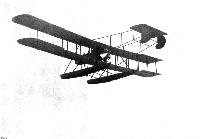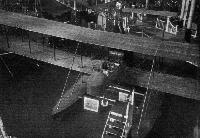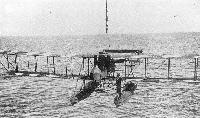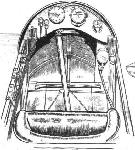P.Lewis British Aircraft 1809-1914 (Putnam)
Wight 1914 Double-camber Navyplane
At the 1914 Olympia Aero Show, J. Samuel White and Co. showed their latest version of the Double-camber Navyplane designed by Howard T. Wright. The new machine was larger than that of the previous year, and was fitted with the more powerful 200 h.p. Canton Unne radial engine which drove a White propeller and was water-cooled through radiators situated on each side of the rear of the two-seat nacelle. The 1914 Navyplane embodied the results of considerable development-flying carried out with the earlier machine. The "double-camber" idea had proved to be so successful that it was incorporated also in the section used in the propeller, which proved to be superior to the normal types tried with the Canton Unne.
The machine flew for the first time on 7th April, 1914, and several were ordered by the Admiralty, being delivered by May, 1914. The R.N.A.S. production aircraft were made so that their five-bay wings folded, and strut-braced extensions were added to the upper wing-tips. The connecting cables between the four ailerons of the prototype were replaced in the production machines by struts. One example was delivered to Germany. Span, 63 ft. Wing area, 735 sq. ft. Weight empty, 2,600 lb. Weight loaded, 3,500 lb. Maximum speed, 78.9 m.p.h. Landing speed, 35 m.p.h.
Показать полностью
M.Goodall, A.Tagg British Aircraft before the Great War (Schiffer)
Deleted by request of (c)Schiffer Publishing
WIGHT Navyplane 1914 type
This version was exhibited in a near complete condition at the Aero Show at Olympia in March 1914. It was an enlarged version of the 1913 Navyplane, with considerably increased span and a more powerful engine, but was built to the same basic layout.
The wings now consisted of four bays outboard of the center section and were without sweep back. The rudder shape was more rounded, and had a balance area below the bottom tail booms. Tall radiators, of square cross section, were positioned on either side of the nacelle ahead of the engine, which was provided with a compressed air starter. Howard Wright had developed his 'double camber' section also for propellers, and a large two-bladed propeller of this type was fitted. Accommodation was provided for three crew and a radio installation.
A total of seven of these machines was built, six for the RNAS and one for the German government. The first two, Serial Nos. 128-129, were ordered on Contract CP57922/13 and these flew on 8 April 1914 and 2 May 1914 respectively. No. 128 crashed on 4 June 1914, killing two naval officers; No. 129 was wrecked on 29 January 1915. No.155 ordered on CP40819/14 flew on 5 May 1914 and was lost on 11 April 1915.
The fourth machine was launched at Cowes on 16 May 1914 and was flown at Kiel in Germany by Gordon England on 24 June 1914, but crashed with fatal results for the crew on the following day.
The fifth to seventh machines, also ordered by the German government were taken over by the Admiralty under Contract No.CP50287/14 and were all flown for the first time in July and August 1914 becoming serial Nos.893-895.
Power: 200hp Salmson (Canton-Unne) fourteen-cylinder two-row water-cooled radial.
Data
Span top 63ft
Span bottom 59ft
Chord top 6ft 6in
Chord bottom 5ft 6in
Area 735 sq. ft
Weight (Br) 2,600 lb.
Weight allup (Br) 3,500 lb.
Weight (Ger) 2,901lb.
Weight allup (Ger) 4,175 lb.
Speed range 35-69 mph (80 mph for Nos.893-895)
Endurance 6hr
Climb 400 ft per min
WIGHT type A.I, Improved Navyplane
Seven of these 'Improved Navy planes' were ordered by the Admiralty on Contract CP37385/14/X7333 in May 1914. The aircraft, serial Nos.171-177, were delivered at various times from October and into the early part of 1915. Four of the aircraft saw undistinguished service in the eastern Mediterranean. The operations from the seaplane earner Ark Royal were some of the earliest, and conditions at sea and aboard ship caused the aircraft to deteriorate rapidly. The Wight seaplanes never did live up to their original promise and the Navy were soon disillusioned with them.
This type was fitted with folding wings, with a system patented by Howard Wright under patent No. 16924/14, to cater for storage aboard ship. The folding was actuated by a rack and worm wheel at the leading edge, adjacent to the fold joint. As a safety measure the engine could not be started until the wing locking bolts were home. This feature and the general strengthening and additions that had taken place added to the weight and affected the performance. In service the folding gear was removed and the wings were folded manually.
The wings were increased in span, the top wing overhang being supported by struts.
Wing tip floats were fitted, but again these were removed in service. The ailerons were connected top to bottom by struts. A further tailplane was fitted below the top booms and rectangular fins partly filled the last bays. Cross bracing and cables were added to stiffen the tail booms. Water rudders were added to the floats. The radiators were moved forward and raised to protrude above the level of the top wing. Radio equipment, a gun and bombs could be carried.
Power: 200hp Salmson (Canton-Unne) fourteen-cylinder two-row water-cooled radial driving a 9ft 4in diameter Wight 'double camber' propeller.
Data
Span top 71ft
Span bottom 60ft
Chord top 6ft 6in
Chord bottom 5ft 6in
Gap 5ft 7in
Area 780 sq. ft
Length 34ft 2in
Length folded 41 ft 9in
Floats 27ft long
Height 12ft
Weight 3,467 lb.
Weight allup 4,500lb.
Speed range 35-80 mph
Endurance 5hr
Climb 21min to 3,000 ft
WIGHT type A.II Improved Navyplane, Admiralty Type 177
Further changes to the Navyplane resulted in the A.II version, known in service as the Admiralty Type 177, serial number of the last of the previous batch from which it was derived.
More power was provided by the Sunbeam engine, to match the increasing weight, and anticipating the carriage of a torpedo, for which provision was made. The improvement in engine reliability aimed for was not achieved and, with general airframe problems, the type was not well liked in the Navy. The torpedo experiment was abortive as the machine would not lift off the water.
Only four type A.II Navyplanes were ordered on Contract CP02143/14/X16079 on 2 September 1914, identified as serial Nos.831-834, the first being delivered to Calshot on 2 March 1915.
The next Wight-type produced was a tractor machine.
Power: 225hp Sunbeam Mohawk twelve-cylinder water-cooled vee driving a 9ft 6in diameter Lang four-bladed propeller.
Data Dimensions as for type A.I Improved Navyplane.
Weight 3,467 lb.
Weight allup 4,500lb.
Speed 86 mph
Climb 20 min to 3,000ft
Показать полностью
J.Bruce British Aeroplanes 1914-1918 (Putnam)
Wight Pusher Seaplane
ON January ist, 1913, the well-known boat-building company of John Samuel White & Co., of East Cowes, opened an aviation department. The chief designer and manager of the new department was Howard T. Wright, one of Britain’s earliest successful aircraft designers. In view of the company’s long and distinguished connexion with marine craft it was only to be expected that their aircraft would be float seaplanes. The company’s products were named Wight aircraft, a name which represented not only the place of their manufacture but also a neat blending of the names of the company and their chief designer.
A series of single-engined pusher seaplanes were built before the outbreak of war, commencing with the machine which was shown at the Olympia Aero Show in February, 1913. This aircraft introduced two features which were to characterise all the Wight machines designed by Howard Wright: it had a peculiar aerofoil with double camber on the upper surface, and the floats of the undercarriage were so long that no tail-float was needed. The engine was a 160 h.p. Gnome rotary.
The Wight seaplane underwent development and modification throughout 1913. By the time of the 1914 Aero Show a new and enlarged machine had been built, and was exhibited at Olympia. The new Wight had five-bay wings and was powered by a 200 h.p. Salmson water-cooled radial engine. Two large radiator blocks were fitted to the sides of the nacelle just in front of the engine; the nacelle itself was mounted mid-way between the wings. The tailplane was mounted above the upper tail-booms, and there were two horn-balanced elevators. The long floats had three steps each and were made of plywood on an elm framework; each float was divided into six water-tight compartments.
The German government bought a Wight seaplane of the type exhibited, and the British Admiralty also placed contracts for similar machines. When these were built they incorporated a number of modifications.
The most important structural alteration was the introduction of folding wings: the mainplanes were hinged about the rear spar at the struts in line with the floats. The span of the upper wing was increased by several feet, and the extensions were braced by struts. The bracing system between the floats was modified and became more complex, and a new tail-unit was fitted. The tail-boom structure was strengthened and was deeper in side elevation; the tail-unit was a biplane structure, and two rectangular fins were introduced, one in front of each rudder. Enlarged radiators were mounted on the sides of the nacelle in front of the leading edge of the wings.
When the aircraft carrier Ark Royal left Sheerness for the Dardanelles on February 1st, 1915, among her complement of aircraft were two Wight pusher seaplanes. The Ark Royal arrived at Tenedos on February 17th, and her aircraft were put into use immediately; four flights were attempted that same day. Only one was successful, however. It was a reconnaissance of the enemy forts made by Flight Lieutenant G. R. Bromet and Flight Commander H. A. Williamson, flying a Wight pusher seaplane.
The Wights were not an unqualified success, however, for they could not be relied upon to take off from a choppy sea. They were used when conditions permitted, and on March 18th, 1915, Flight Lieutenant R. Whitehead and Lieutenant L. H. Strain flew a Wight over the Turkish forts of the Narrows defences to observe the fire of the ships of the Allied fleet in its unsuccessful and costly attempt to silence the enemy defences. Eight days later, a reconnaissance of the forts was made by Flight Lieutenant Bromet and Sub-Lieutenant W. Park in a Wight.
At the end of March, 1915, Ark Royal went to Mudros to take on a new Wight, but thereafter the pusher seaplane finds no mention in the chronicle of the war.
SPECIFICATION
Manufacturers: J. Samuel White & Co., East Cowes, Isle of Wight.
Power: 200 h.p. Salmson (Canton-Unne).
Dimensions: Span: upper 63 ft, lower 59 ft. Chord: 6 ft 6 in. Gap: 5 ft 7 in.
Areas: Wings: 735 sq ft.
Weights: Empty: 2,600 lb. Loaded: 3,500 lb.
Performance: Maximum speed: 72 m.p.h.
Service Use: Dardanelles: H.M.S. Ark Royal.
Production: At least eleven Wight pushers with the 200 h.p. Salmson were built for the Admiralty, and one was supplied to Germany.
Serial Numbers: 155: built under Contract No. C.P.40818/14. 171-177: built under Contract No. C.P.37385/14. (176 went to the Dardanelles in Ark Royal.) 893-895.
Показать полностью
O.Thetford British Naval Aircraft since 1912 (Putnam)
WIGHT A.I. IMPROVED NAVYPLANE
This larger pusher seaplane was developed from a type first shown at Olympia in February 1913. The five-bay wings, unusual in themselves, were made to fold in production aircraft. Eleven examples were built for the Admiralty with the serial numbers 155, 171 to 177 and 893 to 895. No.176, which appears in the photograph, was one of two Wight Pusher Seaplanes sent to the Dardanelles aboard the seaplane-carrier Ark Royal in February 1915. They were used for reconnaissance flights over the Turkish lines. One 200 hp Salmson radial engine. Loaded weight, 3.500 lb. Maximum speed, 72 mph. Span, 63 ft.
Показать полностью
Jane's All The World Aircraft 1919
Eleven Wight Pusher Seaplanes built for Admiralty for reconnaissance. Two served on the seaplane carrier HMS Ark Royal. One 200 h.p. Salmson engine, offering a speed of 72 mph.
Показать полностью
Журнал Flight
Flight, March 14, 1914.
WHAT THERE WILL BE TO SEE AT OLYMPIA.
THE EXHIBITS.
Wight (Samuel White and Co.). (39.)
THE Wight seaplane exhibited by Messrs. Samuel White and Co. will be somewhat similar to the machine shown in incomplete form at last year's Aero Show, although, of course, several alterations suggested by a great amount of flying during the past season have been effected. Most interesting, from an aerodynamical point of view, is the peculiar double-cambered wing section which several people were rather inclined to scoff at last year but which has since proved its worth. In fact so pleased is its designer, Mr. Howard T. Wright, with it that he has applied it to the propeller also, and with equally good results. We understand that this propeller has been tried against several well-known makes and has proved superior to them, at least for this particular machine.
The engine fitted on this year's machine is a 200 h.p. Salmson mounted at the rear.
Flight, March 28, 1914.
THE OLYMPIA EXHIBITION.
THE EXHIBITS.
WIGHT SEAPLANE (J. SAMUEL WHITE AND CO., LTD.).
THE 200 h.p. seaplane shown on this stand is an enlarged edition of the 160 h.p. machine which has been doing a good deal of flying lately on the south coast piloted by Mr. Gordon England. It is a development of the machine shown in incomplete form at Olympia last year.
The main characteristics of this machine are the unusually long floats and the peculiar double cambered wings invented by its designer, Mr. Howard T. Wright. This particular wing section has proved very efficient in every way. The lift to drift ratio is very good, and the travel of pressure is comparatively small, so that the machine possesses a considerable amount of inherent stability.
The engine fitted is a 200 h.p. water-cooled Salmson (Canton-Unne) mounted on double bearings in the rear of the nacelle and driving a Howard Wright propeller, the blades of which have a similar section to that of the wings. The nacelle is built of spruce throughout, and the various members are connected by ingenious steel clips, some of which are shown in the accompanying sketches. The pilot's and passenger's seats are arranged tandem fashion, and control is by means of a single central lever and a foot-bar. A complete set of instruments is carried, consisting of oil and petrol gauges, air speed indicator, aneroid, clock, revolution indicator, compass and tell-tale glasses. Provision has been made for a wireless set, but this is not fitted at present. To the right of the pilot's seat is mounted a compressed air starter, working at a pressure of 150 atmospheres.
The two main floats, as pointed out previously, are unusually long and are provided with three steps. The nose of the floats is of the displacement type, running gradually into a slightly curved planning surface, at the steps, becoming flatter towards the stern, where the last step is almost perfectly flat. The floats are built up of three-ply wood on a strong framework of elm. They are divided into six watertight compartments, and are further strengthened by a longitudinal partition running throughout the whole length.
The tail planes consist of a fixed stabilising plane, to the trailing edge of which is hinged the elevator. Underneath the stabilizing plane are mounted the twin rudders, which are partly balanced. No tail float is fitted, the main floats being sufficiently long to protect the tail planes against contact with the water when the machine is at rest. The workmanship throughout is extremely good, and one is not surprised, in view of the excellent performances of the 160 h. p. machine, to learn that several of these seaplanes have been ordered by the Admiralty.
Flight, May 29, 1914.
THE "WIGHT" SEAPLANE.
AMONG the ever-increasing number of British seaplanes, few have met with greater success than have Wight seaplanes designed by Mr. Howard T. Wright and built by Messrs. J. Samuel White and Co., Ltd., of Cowes. The excellent performances of these machines are somewhat apt to escape the notice that they certainly merit, since they are at present built for the British and foreign navies only and their flights in public have been limited to trial nights and delivery tests. There is no lack of recognition by our own and foreign governments, however, and several of these machines have already been delivered, whilst sufficient orders have been received to keep the firm very busy indeed for a long time to come.
One of these machines was, it will be remembered, exhibited at the last Olympia Aero Show when it caused considerable interest owing to its many original features. Most notable among these are the unusually long floats, and the peculiar double camber on the upper surface of the wings. It is undoubtedly chiefly due to this double camber that the machine possesses such a good speed range - from 78.9 miles per hour to about 35 m.p.h. with full load of fuel, wireless apparatus, pilot and passenger. The most marvellous point, however, does not so much lie in the speed range itself, although that is uncommonly good, but more in the attitude of the machine throughout the entire range of speeds. The main planes and the tail plane are so designed that as the speed of the machine increases, the lift of the tail plane increases at a different ratio from that of the main planes, in such a manner that, as the speed goes up, the angle of incidence of the main planes in relation to the horizontal decreases without necessitating use of the elevator. When the maximum speed has been reached, the main planes are flying at a negative angle of incidence of 1°, whilst the tail plane has a negative angle of incidence of 4°. Any attempt to increase the speed beyond this point causes a top pressure on the tail plane and the machine begins to climb. It will therefore be seen that it is possible to fly the machine simply by closing or opening the throttle without using the elevator, as longitudinal stability is perfect under all speeds.
The lateral stability is more difficult to explain, but is none the less pronounced. We had occasion recently to observe the machine in flight, and she appears to bank up to the right degree in making a turn without any use of the ailerons, and when flying in a straight line, even on a windy day, the ailerons are rarely called into play.
Excellent as is the behaviour of the machine in the air, her performances when on the sea are almost even more so. The long three-stepped floats leave the water in a perfectly clean manner, without the huge spray of water usually set up while a machine is gathering speed. The nose of the floats leaves the water first, then the first step, and so on, until gradually the whole of the floats leave the water without any jerk whatever. When starting for a flight in a rough sea, the long narrow floats plough their way through the waves without causing the machine to rise and sink with the swell. Alighting on the water is effected by throttling down the engine until a sufficiently low flying speed has been obtained to allow of settling down on the surface of the sea gently and without shock. One of the accompanying photographs shows in a most striking manner the clean wake of the floats under these conditions. When taxying on the surface of the sea the machine answers her rudder beautifully, and it is possible to make a complete circle of only about 30 ft. diameter. With a full load including fuel, wireless apparatus, pilot and passenger, the machine reaches an altitude of 3,000 ft. in 7 1/2 mins., and recently experiments were made with an additional load of 400 lbs., with which the machine reached 3,000 ft. in 13 1/4 mins. By sacrificing the low starting and alighting speed, a much greater load could be carried, but Mr. Howard Wright is - rightly we think - in favour of a machine possessing a wide speed range.
Показать полностью
















